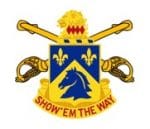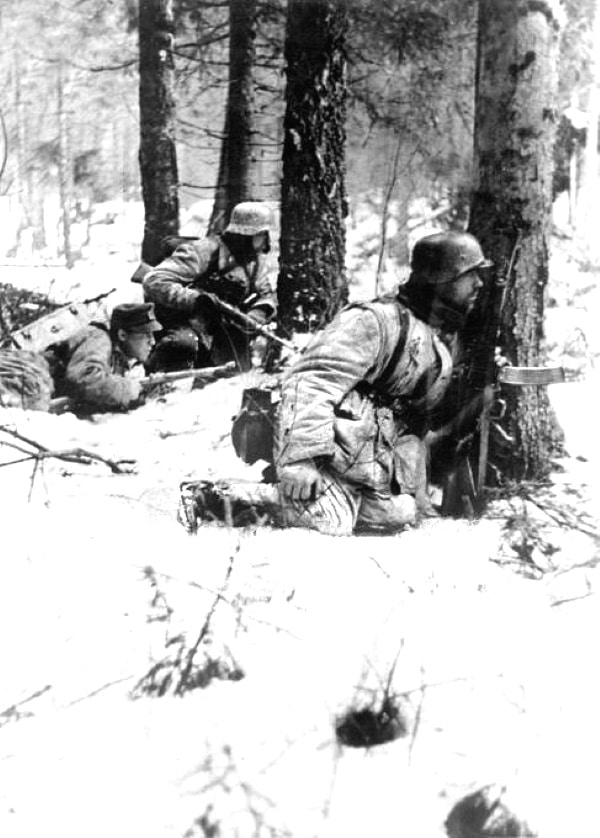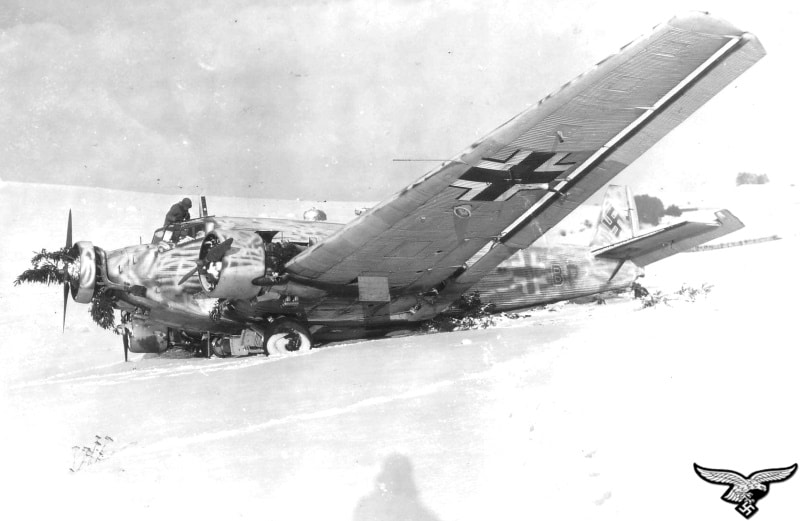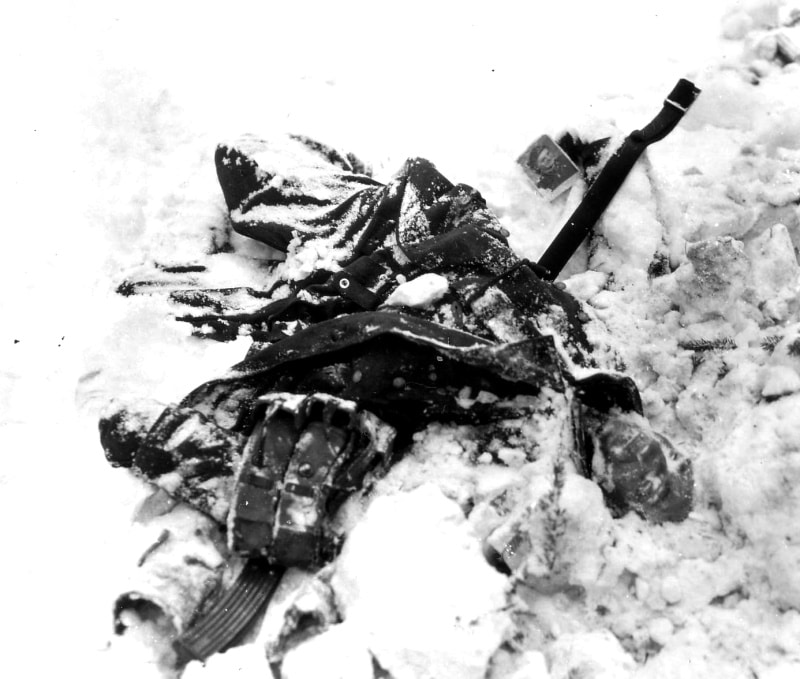 Enemy activity centered on Fox Co and C Troop fronts for the balance of the day, with B and A Troops reporting small patrols operating on their fronts. Artillery continued to harass our lines, and the area east of Monschau was subjected to continual machine gun and sniper firing. Snipers became particularly dangerous in the deep ravines about Merzerath Hill, where the dense cover provided ample protection. One German rifleman was eliminated in a daring one-man patrol by a Fox Co tank driver, T/5 Lucore, who volunteered for the mission when all other efforts had failed. For his gallantry in this action, T/4 Lucore has been recommended for the award of the British Military Medal. At 1015 it was ascertained that the retreating enemy, from the first attack of the morning, had holed up in a group of buildings on the Röhren Road. Tank Destroyers (M-10), which had been brought up to support the 2nd Platoon of Fox Co, placed direct fire on these targets and caused the unusually large explosion, which blew out the sides of the house. Results could not be ascertained but, at 1115, a large group of enemy, estimated to be from 60 to 80 men were caught in the open at (K954177) and placed under effective artillery fire. Casualties were observed, but could not be accurately counted.
Enemy activity centered on Fox Co and C Troop fronts for the balance of the day, with B and A Troops reporting small patrols operating on their fronts. Artillery continued to harass our lines, and the area east of Monschau was subjected to continual machine gun and sniper firing. Snipers became particularly dangerous in the deep ravines about Merzerath Hill, where the dense cover provided ample protection. One German rifleman was eliminated in a daring one-man patrol by a Fox Co tank driver, T/5 Lucore, who volunteered for the mission when all other efforts had failed. For his gallantry in this action, T/4 Lucore has been recommended for the award of the British Military Medal. At 1015 it was ascertained that the retreating enemy, from the first attack of the morning, had holed up in a group of buildings on the Röhren Road. Tank Destroyers (M-10), which had been brought up to support the 2nd Platoon of Fox Co, placed direct fire on these targets and caused the unusually large explosion, which blew out the sides of the house. Results could not be ascertained but, at 1115, a large group of enemy, estimated to be from 60 to 80 men were caught in the open at (K954177) and placed under effective artillery fire. Casualties were observed, but could not be accurately counted.

 Later in the day, three Germans who had been thought to be dead were observed moving in front of the platoon. T/4 Steiner called upon them to surrender but fired upon. In the resulting firefight, all three Germans were killed. at 1130, a C Troop outpost, under the command of Cpl Paul J. Ridge, captured one German at (K947188). At 1455 an enemy patrol was observed by B Troop in the vicinity of (K950198). One of the Germans was killed and the rest withdrew before further action could be taken. A Troop repulsed several patrols, taking two NCO prisoners when they shook out of a haystack with hand grenades. They were members of a reconnaissance party from the 2.Company 751/326.VGD and were sent to headquarters of the 102-CG for interrogation.
Later in the day, three Germans who had been thought to be dead were observed moving in front of the platoon. T/4 Steiner called upon them to surrender but fired upon. In the resulting firefight, all three Germans were killed. at 1130, a C Troop outpost, under the command of Cpl Paul J. Ridge, captured one German at (K947188). At 1455 an enemy patrol was observed by B Troop in the vicinity of (K950198). One of the Germans was killed and the rest withdrew before further action could be taken. A Troop repulsed several patrols, taking two NCO prisoners when they shook out of a haystack with hand grenades. They were members of a reconnaissance party from the 2.Company 751/326.VGD and were sent to headquarters of the 102-CG for interrogation.
Throughout the afternoon, observation and outposts reported the enemy loading pillboxes. Prisoner of war statements indicated that the attack of the morning had been in battalion strength and, because enemy patrols were composed of officers or senior non-commissioned officers, it was believed that these were reconnaissance patrols preliminary to a large-scale attack. At 1240, immediate reinforcement was requested of the 102-CG. For the night of Dec 16/17, our patrol activity was increased and additional listening posts were put well out in front of all troops. Two additional armored cars, with crews, were brought from the Squadron rear echelon in Eupen to supplement the command post-security in Monschau.  Capt Robert Marvel, CO HQs and Service Troop was assigned as commander of a V Corps security area, with the mission of coordinating the security of certain road nets, bridges and towns in the Corps rear areas; in addition, armored car patrols were maintained on the roads west of Corps Headquarters. Six machine guns and crews, furnished by the 186-FAB and attached tank destroyers, were attached to Fox Co. The guns were put into position at dusk in support of the 2nd Platoon; two in a school building at (K945135); and four between the platoon right flank and the 395-IR, in the vicinity of (K944181). The Squadron suffered 7 casualties on this date. Six prisoners, all of the 751/326.VGD was taken and in excess of 50 (known) casualties were inflicted. E Troop fired 32 missions and 760 rounds in support of the Squadron during the twenty-four-hour period.
Capt Robert Marvel, CO HQs and Service Troop was assigned as commander of a V Corps security area, with the mission of coordinating the security of certain road nets, bridges and towns in the Corps rear areas; in addition, armored car patrols were maintained on the roads west of Corps Headquarters. Six machine guns and crews, furnished by the 186-FAB and attached tank destroyers, were attached to Fox Co. The guns were put into position at dusk in support of the 2nd Platoon; two in a school building at (K945135); and four between the platoon right flank and the 395-IR, in the vicinity of (K944181). The Squadron suffered 7 casualties on this date. Six prisoners, all of the 751/326.VGD was taken and in excess of 50 (known) casualties were inflicted. E Troop fired 32 missions and 760 rounds in support of the Squadron during the twenty-four-hour period.
 At about 1700, Capt Hall, CO of Able 146-ECB, reported to the Squadron HQs. He was given his mission and proceeded with Capt Meyer in a radio half-track to his company which was mounted and waiting at (989202) on the Eupen highway. A guide was assigned from B Troop to the 2nd Platoon and one from C Troop to the 3rd Platoon and both proceeded to reinforce those units. Capt Hall took his HQs to the Squadron CP and Capt Meyer led the 1st Platoon under Lt Anderson to (938187) where they dug in on the hill to the west of Monschau. The personnel and three heavy machine guns were positioned with excellent fields of fire overlooking the draw to their right flank, Höfen Hill to their right front; the draw occupied by Fox Co, and the Monschau Hill occupied by C Troop to their direct front; the dragon’s teeth to their left front; and the Stillbush draw to their left flank. To prevent detection when daylight appeared, the emplacements were camouflaged with snow and brush. Ammunition and rations were provided.
At about 1700, Capt Hall, CO of Able 146-ECB, reported to the Squadron HQs. He was given his mission and proceeded with Capt Meyer in a radio half-track to his company which was mounted and waiting at (989202) on the Eupen highway. A guide was assigned from B Troop to the 2nd Platoon and one from C Troop to the 3rd Platoon and both proceeded to reinforce those units. Capt Hall took his HQs to the Squadron CP and Capt Meyer led the 1st Platoon under Lt Anderson to (938187) where they dug in on the hill to the west of Monschau. The personnel and three heavy machine guns were positioned with excellent fields of fire overlooking the draw to their right flank, Höfen Hill to their right front; the draw occupied by Fox Co, and the Monschau Hill occupied by C Troop to their direct front; the dragon’s teeth to their left front; and the Stillbush draw to their left flank. To prevent detection when daylight appeared, the emplacements were camouflaged with snow and brush. Ammunition and rations were provided.
 In the meantime, at 2000, Capt Meyer placed his half-track behind the hill near the C Troop mortar battery (934187) and the radio operators reported into the 102-CG and the Squadron nets, thereby establishing an alternate command post.
In the meantime, at 2000, Capt Meyer placed his half-track behind the hill near the C Troop mortar battery (934187) and the radio operators reported into the 102-CG and the Squadron nets, thereby establishing an alternate command post.

 The night of Dec 17/18, was marked by unusual enemy air activity, accompanied by the use of many and varied types of pyrotechnics. Artillery continued to fall in the sector and many robot bombs passed overhead. As many as five searchlights lit up the Mützenich Hill and Imgenbroich. Several reports were received from higher HQs of enemy paratroopers being dropped in areas both north and south of the Squadron sector. Large, low-flying enemy planes passed over all troops, flying from east to west and returning some dropped flares and others carried wing lights. The enemy did not attempt to penetrate our lines during the hours of darkness, although indications of movement beyond our listening posts were reported. Heavy interdiction and harassing fires were maintained by our artillery throughout the night.
The night of Dec 17/18, was marked by unusual enemy air activity, accompanied by the use of many and varied types of pyrotechnics. Artillery continued to fall in the sector and many robot bombs passed overhead. As many as five searchlights lit up the Mützenich Hill and Imgenbroich. Several reports were received from higher HQs of enemy paratroopers being dropped in areas both north and south of the Squadron sector. Large, low-flying enemy planes passed over all troops, flying from east to west and returning some dropped flares and others carried wing lights. The enemy did not attempt to penetrate our lines during the hours of darkness, although indications of movement beyond our listening posts were reported. Heavy interdiction and harassing fires were maintained by our artillery throughout the night.
 At about 0400, T/4 Anderson, in charge of a C Troop listening posts at (K948189], reported a large body of enemy estimated to be 60/70 moving southwest into the draw from Menzerath. In the dark, the Germans were almost on top of the listening post before they were detected. A firefight developed and T/5 Anderson called for and adjusted artillery on the enemy which forced them to withdraw into Menzerath. Casualties inflicted could not be counted, but cries of wounded were heard in the draw until daylight. At 0650, C Troop reported the noise of considerable movement in Menzerath. At 0650 the enemy attacked. Accompanied by a repetition of the previous day’s preparation barrages, a company of the enemy attempted to drive a wedge into Lt Cullinan’s 3rd Platoon positions of Fox Co on the railroad, cut at (K938197), in an effort to out the Squadron’s main supply route at the railroad junction and thus isolate the town of Monschau. This effort proved to be the advanced element of the regimental attack which was launched on Monschau and the Mützenich Hill. Simultaneously, all troop fronts were subjected to severe small arms fire in addition to the heavy artillery concentration. The C Troop mortar positions and the alternate CP half-track at (934187) came under a direct 50-MM round mortar concentration at this time, despite the fact that they were defiladed in a draw with unusually steep sides.
At about 0400, T/4 Anderson, in charge of a C Troop listening posts at (K948189], reported a large body of enemy estimated to be 60/70 moving southwest into the draw from Menzerath. In the dark, the Germans were almost on top of the listening post before they were detected. A firefight developed and T/5 Anderson called for and adjusted artillery on the enemy which forced them to withdraw into Menzerath. Casualties inflicted could not be counted, but cries of wounded were heard in the draw until daylight. At 0650, C Troop reported the noise of considerable movement in Menzerath. At 0650 the enemy attacked. Accompanied by a repetition of the previous day’s preparation barrages, a company of the enemy attempted to drive a wedge into Lt Cullinan’s 3rd Platoon positions of Fox Co on the railroad, cut at (K938197), in an effort to out the Squadron’s main supply route at the railroad junction and thus isolate the town of Monschau. This effort proved to be the advanced element of the regimental attack which was launched on Monschau and the Mützenich Hill. Simultaneously, all troop fronts were subjected to severe small arms fire in addition to the heavy artillery concentration. The C Troop mortar positions and the alternate CP half-track at (934187) came under a direct 50-MM round mortar concentration at this time, despite the fact that they were defiladed in a draw with unusually steep sides.
Between 0700 and 0715, the 3rd Platoon of Fox Co was engaged in a fierce firefight. Employing all tank weapons as well as artillery support, they finally succeeded in driving the attackers back into the ravine at (K940220) with heavy losses. Eleven enemies dead were counted at the railroad cut and in the ravine by S/Sgt Lindquist, as a result of this action. Two Germans, who had been pinned down by machine gun fire at the railroad embankment, were captured and brought in by Sgt Strubble and Pvt Terrell.
 Upon withdrawing, the balance of the enemy split into two groups; one proceeding up the draw to the north, and the other south, toward Monschau. The record wave of the German attack had come up, however, and at about 0800 commenced the assault of the high ground in Mutzenich. They were engaged by the 1st and 2nd Platoons of B Troop, who defended positions along a line of over 2000 yards from (K930203) to (K936220). The 3rd Platoon of Fox Co continued to lend support by firing with their tanks along the line of the railroad tracks, to the north.
Upon withdrawing, the balance of the enemy split into two groups; one proceeding up the draw to the north, and the other south, toward Monschau. The record wave of the German attack had come up, however, and at about 0800 commenced the assault of the high ground in Mutzenich. They were engaged by the 1st and 2nd Platoons of B Troop, who defended positions along a line of over 2000 yards from (K930203) to (K936220). The 3rd Platoon of Fox Co continued to lend support by firing with their tanks along the line of the railroad tracks, to the north.
At 0800, the enemy attacked from the draw at the hairpin turn (K941199) and down the Snake Road from Imgenbroich in company strength. Both forces were engaged by Lt Ketz with the 1st Platoon of Fox Co and the left flank of the C Troop trenches. Simultaneously, the C Troop listening post at (K949189) manned by T/5 Anderson and Van Order which had reported the enemy concentration at 0400, observed about 25 Germans crossing the draw from Menzerath towards their troop front. Artillery was placed on this latter group immediately, effectively dispersing them and inflicting a few known casualties. Meanwhile, the fight in the deep ravine, north of Monschau and along the Snake Road, became an enemy debacle. In addition to the artillery supporting fire, light tanks, and .50 Cal machine guns from the C Troop trenches all delivered a terrific fire at the enemy advancing through this canalized approach. Fox Co’s attached tank destroyers were employed to fire directly into the buildings along this road, denying their use to the enemy. AAA batteries in position on the hill north of the railroad junction (K937197), were contacted by Capt Meyer, assistant S-3, and delivered overhead fire along with the dragon’s teeth, across the top of the C Troop trenches.
An enemy build-up that had commenced along the left flank of C Troop was thus driven back with heavy casualties. Also during this engagement, enemies concentrating in the vicinity of Stillbusch (K944202) and in the woods at (K940208) were taken under long-range machine gun fire by the 1st and 3rd Tank Platoons. E Troop fired counter battery on and destroyed an enemy self-propelled gun which had moved forward from Imgenbroich to a position at (K954204). The 1st Platoon of Fox Co took 7 prisoners at the blown bridge (K942196) who had been pinned down by their tank fire and surrendered. Also at 0600, enemy paratroopers became active behind our lines.
 A number of parachutes canopies and even aerial delivery metallic containers were found in the troop rear areas. HQs Platoon was organized for patrols and all-around defense. Although it was later learned that approximately one battalion of Col von der Heydte’s paratrooper regiment had been dropped in the woods in the rear of the Squadron sector, only one attack in force materialized from this threat. As the large-scale assault was developing on the B Troop front an estimated platoon of paratroopers struck at the rear of the Troop’s 3rd Platoon position (K935229). Forced to draw on his already lightly held MLR, the platoon commander organized a combat patrol under Sgt Becker, which entered the dense forest in this area and, flanking the Germans, drove them to the south. One casualty and prisoner took, who confirmed the unit identification.
A number of parachutes canopies and even aerial delivery metallic containers were found in the troop rear areas. HQs Platoon was organized for patrols and all-around defense. Although it was later learned that approximately one battalion of Col von der Heydte’s paratrooper regiment had been dropped in the woods in the rear of the Squadron sector, only one attack in force materialized from this threat. As the large-scale assault was developing on the B Troop front an estimated platoon of paratroopers struck at the rear of the Troop’s 3rd Platoon position (K935229). Forced to draw on his already lightly held MLR, the platoon commander organized a combat patrol under Sgt Becker, which entered the dense forest in this area and, flanking the Germans, drove them to the south. One casualty and prisoner took, who confirmed the unit identification.
At 0830, the 2nd Platoon of Fox Co repulsed a strong patrol that approached from Menzerath Hill. One prisoner was taken and two battalions of the 751.VGR was now identified on the squadron front. Accurate enemy shelling continued to fall on the platoon positions during the balance of the day. By 0900, the attack had built-in full battalion strength on the B Troop front, the troop commander, Capt Joseph Sain requested tank support. A section of light tanks under Sgt Petrucci was dispatched and placed in support of the 2nd Platoon. The enemy continued to maintain constant pressure on the 3rd Platoon of Fox Co and commenced infiltrating among the B Troop outposts from the draw at (K941203). C Troop and forward observers continued to place artillery and mortars on enemy reserve forces concentrating in the Menzerath and Imgenbroich areas at (K947193), (K951191), (K948196), and (K938197) observed an enemy mortar 900 yards to the left front and put it out of action with 37-MM fire.

 At 0930, the situation in the B Troop sector grew critical, and the squadron commander left the CP, then under artillery fire, to give the threatened enemy break through his personal attention. At 0939, tank destroyers in support of B Troop’s right flank positions reported the enemy closing in the area (K9320). At this same time, infiltration of about sixty-five men was confirmed by the 1st and 2nd Platoons of B Troop, and a message was sent to HQs 102nd Cavalry Group reporting infiltration in the south sector and requesting help.
At 0930, the situation in the B Troop sector grew critical, and the squadron commander left the CP, then under artillery fire, to give the threatened enemy break through his personal attention. At 0939, tank destroyers in support of B Troop’s right flank positions reported the enemy closing in the area (K9320). At this same time, infiltration of about sixty-five men was confirmed by the 1st and 2nd Platoons of B Troop, and a message was sent to HQs 102nd Cavalry Group reporting infiltration in the south sector and requesting help.
























